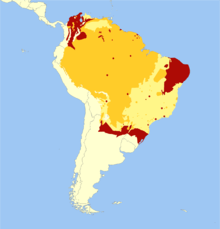South American tapir
| South American tapir | |
|---|---|
| | |
| on Cristalino River Southern Amazon, Brazil | |
| Scientific classification | |
| Kingdom: | Animalia |
| Phylum: | Chordata |
| Class: | Mammalia |
| Order: | Perissodactyla |
| Family: | Tapiridae |
| Genus: | Tapirus |
| Species: | T. terrestris |
| Binomial name | |
| Tapirus terrestris (Linnaeus, 1758) | |
 | |
| South American tapir distribution Extinct Extant Probably extant | |
The South American tapir (Tapirus terrestris), Brazilian tapir (from the Tupi tapi'ira), lowland tapir or (in Portuguese) anta, is one of five species in the tapir family, along with the Mountain tapir, the Malayan tapir, the Baird's tapir,[3] and the kabomani tapir.[4] The lowland tapir is the largest native terrestrial mammal in the Amazon.[5]
Appearance
It is dark brown, paler in the face, and has a low, erect crest running from the crown down the back of the neck. The round, dark ears have distinctive white edges. Newborn tapirs have a dark brown coat, with small white spots and stripes along the body. The South American tapir can attain a body length of 1.8 to 2.5 m (5.9 to 8.2 ft) with a 5 to 10 cm (2.0 to 3.9 in) short stubby tail and an average weight around 225 kg (496 lb). Adult weight has been reported ranging from 150 to 320 kilograms (330 to 710 lb).[6]

Range
The South American tapir can be found near water in the Amazon Rainforest and River Basin in South America, east of the Andes. Its range stretches from Venezuela, Colombia, and the Guianas in the north to Brazil, Argentina, and Paraguay in the south, to Bolivia, Peru, and Ecuador in the West.
Behavior
Lowland tapirs are excellent swimmers and divers, but also move quickly on land, even over rugged, mountainous terrain. They have a life span of approximately 25 to 30 years. In the wild, their main predators are crocodilians (only the black caiman and Orinoco crocodile, the latter of which is critically endangered, are large enough to take these tapirs, as the American crocodile only exists in the northern part of South America) and large cats, such as the jaguar and cougar, which often attack tapirs at night when they leave the water and sleep on the riverbank. Brazilian tapirs are also attacked by green anacondas. They are known to run to water when scared to take cover.
There is also a need for more research to better explore social interactions.[7]
Diet
It is an herbivore. Using its mobile nose, the tapir feeds on leaves, buds, shoots, and small branches it tears from trees, fruit, grasses, and aquatic plants. This is known because the diet is studied through observation of browsing, analysis of feces, and studying stomach contents.[8]
Mating
They mate in April, May, or June, reaching sexual maturity in their third year of life. Females go through a gestation period of 13 months (390–395 days) and will typically have one offspring every two years. Newborn tapirs weigh about 15 pounds and will be weaned in about six months.
Endangered status
Dwindling numbers are due to poaching for meat and hide, as well as habitat destruction. The South American tapir is generally recognized as an endangered animal species, with the species being designated as endangered by the United States Fish and Wildlife Service on June 2, 1970.[9] It has a significantly lower risk of extinction, though, than the other four tapir species.
Gallery
- Young Brazilian tapir at the Dortmund Zoo
- Brazilian tapir in northern Peru
.jpg) Tapir heart (Tapirus terrestris)
Tapir heart (Tapirus terrestris)
References
- ↑ Naveda, A.; de Thoisy, B.; Richard-Hansen, C.; Torres, D.A.; Salas, L.; Wallance, R.; Chalukian, S. & de Bustos, S. (2008). "Tapirus terrestris". IUCN Red List of Threatened Species. Version 2008. International Union for Conservation of Nature. Retrieved 10 April 2009. Database entry includes a brief justification of why this species is of vulnerable.
- ↑ "Tapir Specialist Group". Retrieved 6 April 2016.
- ↑ Grubb, P. (2005). "Order Perissodactyla". In Wilson, D.E.; Reeder, D.M. Mammal Species of the World: A Taxonomic and Geographic Reference (3rd ed.). Johns Hopkins University Press. p. 634. ISBN 978-0-8018-8221-0. OCLC 62265494.
- ↑ Hance, Jeremy. "Scientists make one of the biggest animal discoveries of the century: a new tapir". Mongabay. Retrieved 17 December 2013.
- ↑ Montenegro, Olga Lucia. The Behavior of Lowland (Tapirus terrestris) at a Natural Mineral Lick in the Peruvian Amazon. Rep. N.p.: University of Florida, 1998.
- ↑ (1) "Tapirus terrestris: Brazilian tapir (Also: South American tapir)". ADW: Animal Diversity Web. Ann Arbor, Michigan: University of Michigan Museum of Zoology. Archived from the original on 2014-07-06. Retrieved 2014-08-18. External link in
|publisher=, |work=(help)
(2) "Tapir (Tapirus terrestris)". Rainforest Expeditions. Archived from the original on 2011-07-15. Retrieved 2014-08-18. External link in|publisher=(help) - ↑ Pinho GM, Goncalves da Silva A, Hrbek T, Venticinque EM, Farias IP (2014) Kinship and Social One 9(3): e92507. doi: 10.1371/ journal. pone. 0092507
- ↑ Hibert F, Sabatier D, Andrivot J, Scotti-Saintagne C, Gonzalez S, et al. (2011) Botany, Genetics and Ethnobotany: A Crossed Investigation on the Elusive Tapir's Diet in French Guiana. PLoS ONE 6(10): e25850. doi: 10.1371/journal.pone.0025850
- ↑ "Endangered and threatened wildlife: Tapir, South American (=Brazilian)" (PDF). 50 CFR §17.11(h). United States Government Printing Office. 2013-10-01. p. 23. Retrieved 2014-08-18.
External links
| Wikimedia Commons has media related to: |
- ARKive - images and movies of the lowland tapir (Tapirus terrestris)
- Tapir Specialist Group - Lowland Tapir
